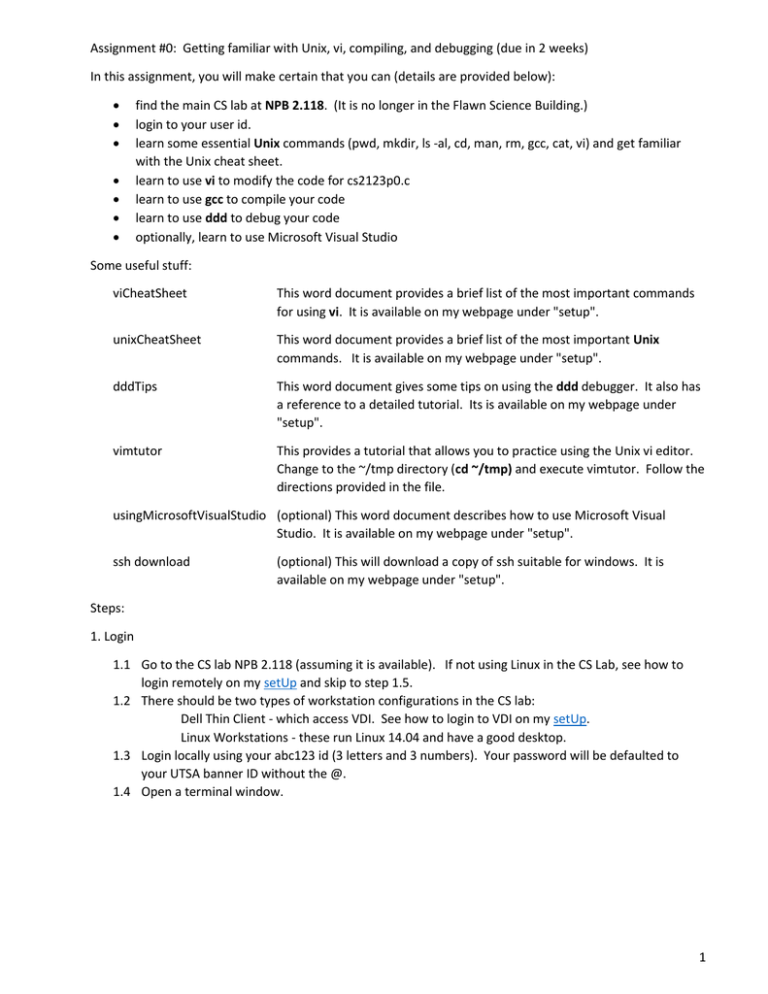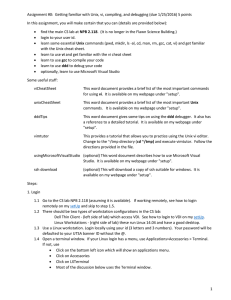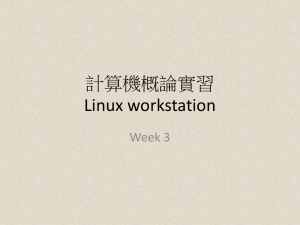Program #0: Familiarity (5 pts)
advertisement

Assignment #0: Getting familiar with Unix, vi, compiling, and debugging (due in 2 weeks) In this assignment, you will make certain that you can (details are provided below): find the main CS lab at NPB 2.118. (It is no longer in the Flawn Science Building.) login to your user id. learn some essential Unix commands (pwd, mkdir, ls -al, cd, man, rm, gcc, cat, vi) and get familiar with the Unix cheat sheet. learn to use vi to modify the code for cs2123p0.c learn to use gcc to compile your code learn to use ddd to debug your code optionally, learn to use Microsoft Visual Studio Some useful stuff: viCheatSheet This word document provides a brief list of the most important commands for using vi. It is available on my webpage under "setup". unixCheatSheet This word document provides a brief list of the most important Unix commands. It is available on my webpage under "setup". dddTips This word document gives some tips on using the ddd debugger. It also has a reference to a detailed tutorial. Its is available on my webpage under "setup". vimtutor This provides a tutorial that allows you to practice using the Unix vi editor. Change to the ~/tmp directory (cd ~/tmp) and execute vimtutor. Follow the directions provided in the file. usingMicrosoftVisualStudio (optional) This word document describes how to use Microsoft Visual Studio. It is available on my webpage under "setup". ssh download (optional) This will download a copy of ssh suitable for windows. It is available on my webpage under "setup". Steps: 1. Login 1.1 Go to the CS lab NPB 2.118 (assuming it is available). If not using Linux in the CS Lab, see how to login remotely on my setUp and skip to step 1.5. 1.2 There should be two types of workstation configurations in the CS lab: Dell Thin Client - which access VDI. See how to login to VDI on my setUp. Linux Workstations - these run Linux 14.04 and have a good desktop. 1.3 Login locally using your abc123 id (3 letters and 3 numbers). Your password will be defaulted to your UTSA banner ID without the @. 1.4 Open a terminal window. 1 Click on the bottom left icon which will show an applications menu. Click on Accessories Click on LXTerminal Most of the discussion below uses the Terminal window. It will be similar to this: 1.5 Since your Linux password was defaulted, change your password using the passwd command. (Note that the "$" is being used to indicate that the Linux shell is prompting you for input. The actual prompt may include your user id.) In the terminal window type (you don't type the $): $ passwd Please provide a new password. 2 2. Check out some Unix directory-related commands. (You may want to look at the unixCheatSheet.) All the information below is done within a Linux terminal window. If you already are fairly familiar with Linux, skip to step 3. 2.1 After logging in, check your current directory using print working directory: $ pwd 2.2 See what files are in your directory: $ ls -al This will list all files with long details. You should notice some dot files (begin with ".") such as .vimrc 2.3 See your disk usage: $ quota -v If you have had this account for a while, you may need to remove some of your old files. Be careful not to remove important dot files. 2.4 Create a directory for cs2123: $ mkdir cs2123 2.5 Change to your cs2123 directory: $ cd cs2123 Verify that you are in that directory by using the pwd command. 2.6 Change back to your home directory: $ cd ~ Verify your current directory using pwd. 2.7 If you are already familiar with Linux, skip the rest of section 2. The following are done to practice creating directories and subdirectories: 2.7.1 Create a subdirectory called Fruit and another called Veggie under your home directory. By convention, capitalize the first letter in the name of non-system directories. Filenames are case sensitive. $ mkdir Fruit $ mkdir Veggie 2.7.2 Create two subdirectories under Fruit called Apple and PineApple. $ cd Fruit $ mkdir Apple $ mkdir PineApple 2.7.3 Change directory to the Apple directory and then use pwd to check where you are: $ cd Apple $ pwd 2.7.4 Create a subdirectory under Apple called Green $ mkdir Green 2.7.5 Go up to the Fruit directory by using $ cd .. $ pwd Note that cd .. took you up one directory. 2.7.5 You can specify multiple directories in a path when using cd $ cd Apple/Green $ pwd You should be in ~/Fruit/Apple/Green 2.7.6 Go to the Veggie directory using ~ for the home directory. $ cd ~/Veggie $ pwd 2.7.7 See what files exist now in your account. $ cd ~ 3 $ ls -alR This lists files recursively following subdirectories.If you have more than a page worth of files, use ls -alR | more. The pipe symbol "|" is used to redirect the output of the ls command to the input of the more command. To exit out of more, type q for quit. 2.8 Use the man command to see how it gives you manual pages for most Unix commands by typing man command. You can scroll through the manual pages by pressing the space bar to scroll a page or enter key to scroll fewer lines. To quit out of man, type q. $ man ls 2.9 Practice using the find and rm commands. 2.9.1 Use the find command to find all files containing the word "Apple". $ find . -name "*Apple*" 2.9.2 Use the rm command to remove the fruit folder and all its contents. $ rm -r Fruit 2.9.3 Use the up arrow several times to get Linux to show the find command you did. If you go up too far, use the down arrow. Execute that find again and notice that it doesn't find the Apple and PineApple directories. 2.9.4 Remove the veggie directory. 3. Use the vi editor. Sometimes, you won't hav a full Linux desktop so it will be necessary to use vi. Some people love vi and some hate it. It grows on you. 3.1 Look at the viCheatSheet. 3.2 If you are not familiar with vi, try the vi tutorial: 3.2.1 $ cd ~/tmp If you don't have a tmp directory, create one. 3.2.2 $ vimtutor (follow the instructions in that file) 3.2.3 When you are finished with the tutorial, type q! to exit vi. 3.3 Create a .vimrc file to help you with indentation and showing line numbers. 3.3.1 $ cd ~ 3.3.2 Use the Unix cat command to create that file (input is terminated by pressing the CTRL-D key). Note that this only has to be done once. $ cat >.vimrc :set ai sw=4 :set number :set expandtab :set softtabstop=4 :set smartindent CTRL-D 3.4 Create your first program for this class. (Create the cs2123 folder if you haven't already.) 3.4.1 $ cd ~/cs2123 3.4.2 Copy the code (details of how to do this are shown in 3.4.2.1), include file and data from my web page: cs2123p0.c - contains most of the code for program #0. You will have to make several changes: getCustomerData - replace the function documentation header with a good one based on my programming standards printCustomerData - change the code to print the customer data as stated in the function documentation header for printCustomerData. printCustomerData - replace the function documentaiton header with a good one based on my programming standards In the program documentation header, specify your name. 4 cs2123p0.h - include file for this assignment cs2123p0Input.txt - data file to be used with this assignment 3.4.2.1 Invoke the firefox browser: $ firefox 3.4.2.2 The firefox internet browser will open. Within firefox, go to my webpage: http://www.cs.utsa.edu/~clark 3.4.2.3 Go to my Programming Assignments web page. For each of the files (some of which you must rename): Right click on the file. Save it into your cs2123 folder, renaming it if necessary. You may want to check to see if the files contain a combination of carriage returns (\r) and line feeds (\n) which happens when some file are copied from Microsoft Windows. See the setUp page. Use vi to make your changes (as described in 3.4.2) $ vi cs2123p0.c 3.4.3 3.4.4 4. Compile your program, naming the executable p0: $ gcc -g -o p0 cs2123p0.c where -g tells the compiler to generate information suitable for the debugger, -o specifies the name of the result (in this case an executable) This compiles cs2123p0.c, creating an intermediate compiled object file, and generates an executable named p0. Until we have more complex assignments, we will use that form of the gcc. If you have any compilation errors, the compiler will tell you the line number. Correct your mistakes using vi and repeat step 4. 5. Execute your program using the provided input file. $ ./p0 < cs2123p0Input.txt You can look at the output by piping the result to more (use q to quit, Enter to advance 1 line, SpaceBar to advance many lines): $ ./p0 < cs2123p0Input.txt | more You can save the output in a file by redirecting stdout to a file using ">": $ ./p0 < cs2123p0Input.txt > p0Out.txt 6. Use the debugger. 6.1 Look at dddTips.docx under my setup web page. You will find it important to refer to that information while using ddd. 6.2 Invoke the ddd debugger. (Note that if you didn't use the -g compiler switch, the debugger will not work. Also, if you are not executing from a Unix terminal window, ddd will probably not work.) $ ddd ./p0 You may want to show the line numbers for each statement. See dddTips. 6.3 You will see the ddd screen which has the following areas: Menu Bar This is at the menu at the top of the window and includes File, Edit, View, etc. 5 Tool Bar This is immediately below the menu bar and contains some important tools like Find and Break. Data Area At the beginning, this shows an empty grid area. It is used to show values of variables which you wish to closely examine. Source File Area This displays your source code. Command Tool Area This appears on the right side of the Source File Area and includes buttons: Console Area 6.4 Run run the program. Step execute the current step. It will step into a called function. Next execute the current step, but do not step into a called function. Cont Continue execution until the next break or stdin. Finish continue execution until the finish of the current function. Kill Kill the execution of your program. This is at the bottom of the screen: debugger commands are shown/entered standard input is entered (depending on preferences) standard output is shown (depending on preferences) Tell ddd to show line numbers. This is done via the Source menu item. Source > Display Line Numbers 6.5 Run your code using the Program menu item. Click on Run in Execution Window to give you an execution window when you run. You only have to do this once. Run your code using Program > Run. Tell the Run dialogue window to use the input file. For arguments, specify: < cs2123p0Input.txt Click the Run button in that Run Program dialogue window. Your program should run to completion unless there is a bug. If it didn't work and you wish to terminate the program press the Kill button in the Command Tool Area. 6.6 Set a Breakpoint on the first printf statement in getCustomerData(). Click on its line number, right click to get a submenu, and then select Set Breakpoint. A stop sign will appear on that line. This will cause the code to break execution so that you can examine what is happening at a point in the code. You can set many breakpoints. 6.7 Run your code using Program > Run. Again tell the Run dialogue window to use the input file. For arguments, specify: < cs2123p0Input.txt 6 6.8 Execution should have stopped at the first break point. Notice that an arrow will appear in the Source File Area indicating the current statement to execute. In this section, you will step through your code using the Next button and examine variable values. You can hover the cursor over a variable to see its value. Try the Cont (continue) button. It will continue executing until it hits a breakpoint. Eventually hit the Finish button. It will ignore breakpoints in getCustomerData() until it returns from getCustomerData(). Continue executing until the program completes. 6.9 Execute your program again. It is often necessary to see what is happening with your variables. You can display variables in the Data Area. Examining arrays is a little more difficult. Arrays and complex structures are usually shown in the Display Area. Right click on the customer array and select Display. If your variable is a pointer, you might prefer to display what it references by selecting Display*. Sometimes, it it easier to display a slice of the array. Please see the dddTips for more information. Step through your code using Next and see how the values in the Display Area change. When you get to the statement which invokes the getToken function: If you use Next, ddd will execute that function and then return. If you use Step (which means step into), ddd will step into that function, allowing you to use Next to within that function. If you want to stop debugging, use the Kill button in the Command Tool Area. 6.10 Another useful feature is to tell ddd to interrupt execution when a particular variable's value changes. Clear all your breakpoints by clicking on each breakpoint and then pressing Delete Breakpoint. Insert a new breakpoint at the call to getCustomerData(). Run your program using the input file. It will stop at getCustomerData(). Insert a Watch point to watch for when the iNumberOfCustomers in main() changes. (This is done by clicking on that variable and then selecting the watchpoint button, which looks like two eyeballs, on the main tool bar.) Press Cont to continue execution. Notice that execution stops when that variable changes even though it is the corresponding parameter. When you are finished using ddd, type quit in the Debugger Console. 7. We want to save the output of your program by redirecting the output to p0Out.txt $ ./p0 < cs2123p0Input.txt >p0Out.txt That redirected the stdin (standard input) to come from cs2123p0Input.txt and stdout (standard output) to p0Out.txt. To save the output when using Microsoft VS, see the instructions in setup. 8. Upload your results to blackboard. How do I login to blackboard? From the utsa main web page, www.utsa.edu: 7 1. 2. 3. 4. 5. On the menu at the top of the page, select: myUTSA > Blackboard Learn Enter your abc123 id. Enter your pass phrase password. Blackboard will show a list of courses. Select CS2123 (but not the recitation) You will see some items listed on the left side that I provided. Select Programming Assignments Select Program 0 Upload Follow the directions on the screen to upload mutiple files. Upload cs2123p1.c and p0Out.txt 8






